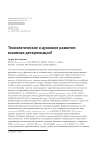Technological and spiritual development: mutual determination?
DOI: 10.33917/mic-1.114.2024.11-24
The paper examines the possible connection between technological and spiritual development, that is, in fact, between economic and non-economic factors of development. The purpose of the study is to identify the possibilities of the modern theory of technological development to explain the effect of the lag in technology development, taking into account the factor of spiritual development, and also to consider the mutual influence of the two types of development. The research methodology consists of the theory of technological structures, approaches to the analysis of technological choice, as well as the method of comparative analysis. The overall result is the conclusion that it is not possible to explain the decline in the level of spiritual development by an increase in the level of technological development. A diagram of the long-term institutional development cycle is obtained – the circulation of institutional forms of life organization based on the assessment of non-economic factors according to the ancient Chinese philosopher Sima Qiang. It reflects a change in preferences in agency relationships regardless of technological development and shows the determination of other factors of spiritual development. The given examples, in particular, of Nazi, pre-Nazi and post-Nazi Germany, also serve as an argument that the reverse determination of technological and spiritual development is not fair. The position has been put forward that both types of development still determine one another, that is, they show a positive relationship, and possible regression occurrences may have a nature unrelated to the sources of technology development. A general conclusion has been reached that the studies allegedly revealing the paradox of the lag associated with the difference in the time of the spiritual crisis for different countries are untenable due to many errors in the interpretation and schematic representation of technological and spiritual evolution identified in the study. A “pseudo-paradox” arises, and the real problem of the lag comes down to the fixation and emerging dependence at the level of technology and institutional-organizational structures, which does not allow overcoming this lag.
References:
1. Kleiner G.B. Economy. Modeling. Mathematics. Selected works. M.: CEMI RAS, 2016. 856 p.
2. Lvov D.S., Glazyev S.Yu. Theoretical and applied aspects of scientific and technological progress management. Economics and mathematical methods. 1986;5:793–804. (In Russ.).
3. Perez K. Technological revolutions and financial capital. Dynamics of bubbles and periods of prosperity. M.: Delo, 2011. 232 p.
4. Skobelev D.O. Mathematical model for determining the best available technologies. Competence. 2019;9–10:64–67. (In Russ.).
5. Sukharev O.S. Economics of industry, technology and intellectual firms. M.: Lenand, 2022. 304 p.
6. Sukharev O.S. Technological sovereignty: solutions at the macroeconomic and sectoral level. Microeconomics. 2023;2:19–33 (In Russ.).
7. Heiman S.A. Scientific and technological revolution today and tomorrow. M.: Politizdat, 1977. 328 p.
8. Chichkanov V.P., Sukharev O.S., Vorobyova M.V. Scientific and technological development of Russia: problems of measurement in a regional context. Bulletin of the OPK of Russia, 2022;3:74–79. (In Russ.).
9. Antonelli C., Gehringer A. Technological change, rent and income inequalities: A Schumpeterian approach. Technological Forecasting & Social Change. 2017;115:85–98.
10. Breschi S., Malerba F., Orsenigo L. Technological Regimes and Schumpeterian Patterns of Innovation. The Economic Journal. 2000;110 (463):388–410.
11. Dattée B., Weil H.B. Dynamics of social factors in technological substitutions, Technological Forecasting and Social Change. 2007;74(5):579–607.
12. Erebak S., Turgut T. Anxiety about the speed of technological development: Effects on job insecurity, time estimation, and automation level preference. The Journal of High Technology Management Research. 2021;32(2):100419.
13. Hanusch H., Pyka A. Manifesto for Comprehensive Neo-Schumpeterian Economics History of Economic Ideas. 2007;15 (1):23-41.
14. North D.С. Institutional Change and American Economic Growth. Cambridge University Press; Reissue edition, 2008. 292 p.
15. Perez C. Structural Change and Assimilation of New Technologies in The Economic and Social Systems. Futures, 1983;4 (15):357–375.
16. Glazyev S.Yu. Chinese economic miracle: lessons for Russia and the world. M.: Ves Mir, 2023. 406 p.



